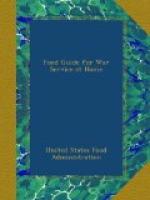Corn and wheat and the other cereals are just as well digested if equally well prepared. A soggy piece of wheat bread may, of course, be less readily digestible than a well-made piece of corn-bread, but that is a question of skill in cooking, not of difference in cereals. Complaints have been heard in England about the war bread. It is true that it may be hard on those of frail digestive powers to change their food habits in any way, but Hutchison, an eminent London physician, in tracing down complaints, found that frequently people laid to the new bread ailments from which they had suffered before the war. “When in doubt, blame the war bread,” seemed to be the motto.
THE SOCIAL IMPORTANCE OF CEREALS, ESPECIALLY WHEAT
The world eats more cereals than any other kind of food. They are so widely available, so cheap and nutritious, that they are a main reliance of the human race. A shortage is always extremely serious.
Not only is an abundance important, but an abundance of the accustomed kind. In parts of India, the inhabitants use rice as almost the only cereal. When the rice-crop failed some years ago, thousands of people died of starvation with a supply of wheat available. They did not know the use of wheat as food.
Countries like France, which use their cereals chiefly for bread, are the most dependent on wheat, since wheat is the most easily made into bread.
In the United States cereals make up almost one-third of our food. Although wheat in most parts of the country has been the main dependence, we have used a much greater variety of cereals than most people, so that it is comparatively simple for the majority to make increased use of them.
The very poor must depend largely upon cereals because they can get more for their money from them than from other foods. Cereals, to most of them, mean bread. It is such a large part of their diet that doing without it means a far more fundamental and difficult change in their food habits than for the well-to-do with greater freedom of choice. Besides, the already overburdened working woman must get her bread in the easiest possible way—a ready-made loaf from the baker. The burden of scarcity or high prices falls on those least able to bear it.
Europeans eat even larger amounts of wheat than we. Over half the food of the French is bread, so if the wheat shortage were near the danger-line, it might lead to a serious weakening of the marvellous courage of the French people.
WHEAT FLOUR IN WAR-TIME
To use this country’s share of the short supply of wheat to the greatest advantage the Food Administration has changed the making of flour to include more of the wheat-kernel. The difference between peace and war time flour is easily understood if the structure of grains is considered. Wheat and other cereals have kernels much alike; all have three principal parts:




